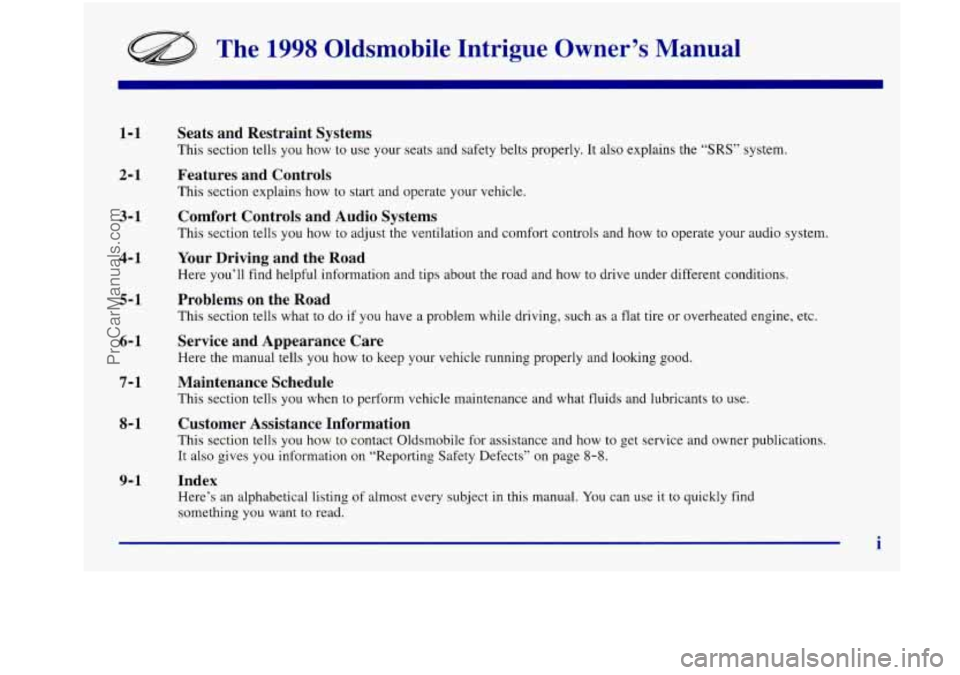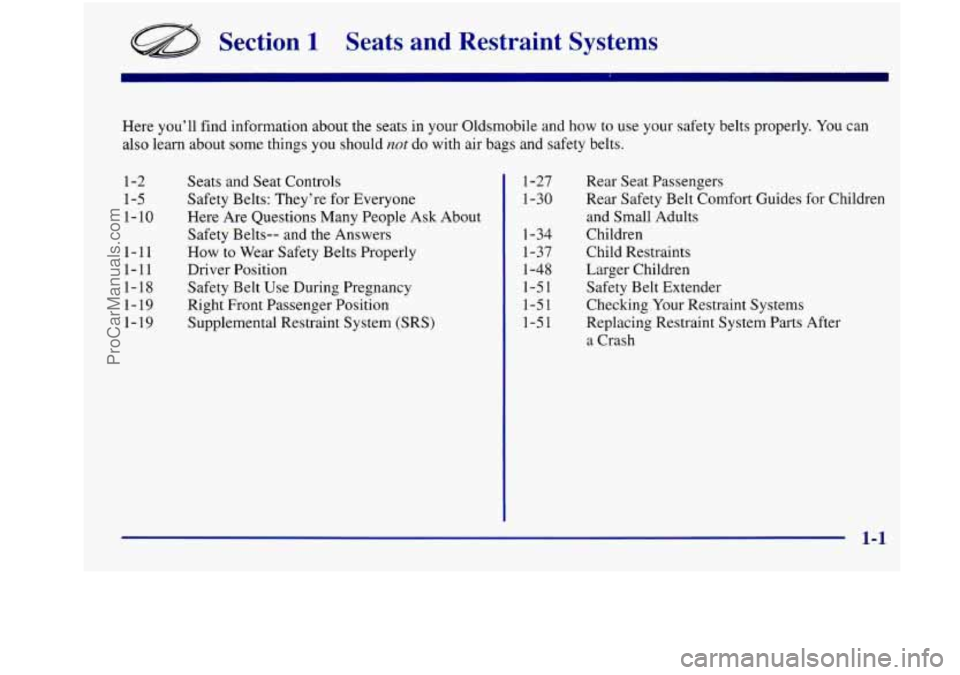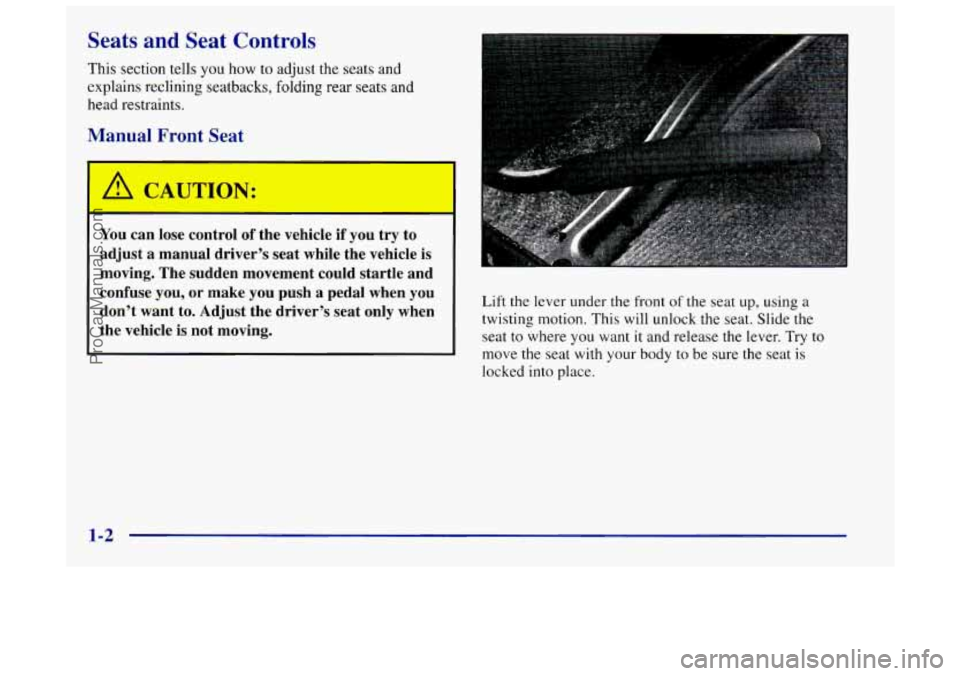seats OLDSMOBILE INTRIGUE 1998 Owners Manual
[x] Cancel search | Manufacturer: OLDSMOBILE, Model Year: 1998, Model line: INTRIGUE, Model: OLDSMOBILE INTRIGUE 1998Pages: 340, PDF Size: 17.93 MB
Page 3 of 340

The 1998 Oldsmobile Intrigue Owner’s Manual
1-1
2- 1
Seats and Restraint Systems
This section tells you how to use your seats and safety belts properly. It also explains the “SRS” system.
Features and Controls
This section explains how to start and operate your vehicle.
3- 1 Comfort Controls and Audio Systems
This section tells you how to adjust the ventilation and comfort controls and how\
to operate your audio system.
4-1
5-1
6-1
7-1
Your Driving and the Road
Here you’ll find helpful information and tips about the road and how to drive under different conditions.
Problems on the Road
This section tells what to do if you have a problem while driving, such as a flat tire or overheated engine, etc.
Service and Appearance Care
Here the manual tells you how to keep your vehicle running properly and looking good.
Maintenance Schedule
This section tells you when to perform vehicle maintenance and what fluids and lubricants to use.
8-1 Customer Assistance Information
This section tells you how to contact Oldsmobile for assistance and how to get service and owner publications.
It also gives you information on “Reporting Safety Defects” on page 8-8.
9- 1 Index
Here’s an alphabetical listing of almost every subject in this manual. You can use it to quickly find
something you want to read.
i
ProCarManuals.com
Page 9 of 340

Section 1 Seats and Restraint Systems
Here you’ll find information about the seats in your Oldsmobile and how to use your safety belts properly. You can
also learn about some things
you should nut do with air bags and safety belts.
1-2 1-5
1-10
1-11
1-11
1-18 1-19
1-19 Seats
and Seat Controls
Safety Belts: They’re for Everyone
Here Are Questions Many People Ask About
Safety Belts-- and the Answers
How to Wear Safety Belts Properly
Driver Position Safety Belt Use During Pregnancy
Right Front Passenger Position
Supplemental Restraint System (SRS) 1-27
1-30
1-34
1-37
1-48
1-5
1
1-5 1
1-5 1 Rear
Seat Passengers
Rear Safety Belt Comfort Guides for Children
and Small Adults
Children
Child Restraints
Larger Children
Safety Belt Extender
Checking Your Restraint Systems
Replacing Restraint System Parts After
a Crash
1-1
ProCarManuals.com
Page 10 of 340

Seats and Seat Controls
This section tells you how to adjust the seats and
explains reclining seatbacks, folding rear seats and
head restraints.
Manual Front Sei- A
A CAUTION:
You can lose control of the vehicle if you try to
adjust
a manual driver’s seat while the vehicle is
moving. The sudden movement could startle and
confuse you, or make you push
a pedal when you
don’t want to. Adjust the driver’s seat only when
the vehicle is not moving.
c I
Lift the lever under the front of the seat up, using a
twisting motion. This will unlock the seat. Slide the
seat to where
you want it and release the lever. Try to
move the seat
with your body to be sure the seat is
locked into place.
1-2
ProCarManuals.com
Page 14 of 340

It is extremely dangerous to ride in a cargo area,
inside or outside of a vehicle. In
a collision,
people riding in these areas are more likely to be
seriously injured or killed.
Do not allow people to
ride in any area
of your vehicle that is not
equipped with seats and safety belts. Be sure
everyone in your vehicle is in a seat and using a
safety belt properly.
- Your vehicle has a light
that comes on as a reminder
to buckle up. (See “Safety
Belt Reminder Light” in
the Index.)
-
In most states and Canadian provinces, the law says to
wear safety belts. Here’s why:
They work.
You never know if you’ll be in a crash. If you do have
a crash, you don’t know if it will be
a bad one.
A few crashes are mild, and some crashes can be so
serious that even buckled up a person wouldn’t survive.
But most crashes are in between, In many
of them,
people who buckle up can survive and sometimes
walk away. Without belts they could have been badly
hurt or killed.
After more than
30 years of safety belts in vehicles,
the facts are clear. In most crashes buckling
up does
matter
... a lot!
1-6
ProCarManuals.com
Page 19 of 340

How to Wear Safety Belts Properly
Adults
This part is only for people of adult size.
Be aware that there
are special things to know about
safety belts and children. And there are different
rules for smaller children and babies.
If a child will
be riding in your vehicle, see the part of this
manual called “Children.” Follow those rules for
everyone’s protection.
First, you’ll want to know which restraint systems
your vehicle has.
We’ll start with the driver position.
Driver Position
This part describes the driver’s restraint system.
Lap-Shoulder Belt
The driver has a lap-shoulder belt. Here’s how to
wear it properly.
1. Close and lock the door.
2. Adjust the seat (to see how, see “Seats” in the Index)
so you can sit up straight.
3.
4.
Pick up the latch plate and pull the belt across you.
Don’t let it get twisted.
The shoulder belt may lock if you pull the belt across
you very quickly.
If this happens, let the belt go back
slightly to unlock
it. Then pull the belt across you
more slowly.
Push the latch plate into the buckle until it clicks.
Pull up on the latch plate to make sure it is secure.
If the belt isn’t long enough, see “Safety Belt
Extender” at the end
of this section.
1-11
ProCarManuals.com
Page 46 of 340

A rear-facing infant restraint (B) positions an infant
to face the rear of the vehicle. Rear-facing infant
restraints
are designed for infants of up to about
20 lbs. (9 kg) and about one year of age. This type
of restraint faces the rear so that the infant’s head,
neck and body can
have the support they need in a
crash. Some infant seats come in two parts
-- the
base stays secured in the vehicle and the seat part
is removable.
1-38
ProCarManuals.com
Page 48 of 340

A booster seat (F, G) is designed for children who
are about
40 to 60 lbs. (1 8 to 27 kg) and about
four
to eight years of age. It’s designed to improve
the fit of the vehicle’s safety belt system. Booster
seats with shields use lap-only belts; however,
booster seats without shields use lap-shoulder
belts. Booster seats can also help a child
to see
out the window.
1-40
ProCarManuals.com
Page 54 of 340

6. Push and pull the child restraint in different directions to be sure it is secure.
To remove the child restraint, just unbuckle the vehicle’s
safety belt. It will be ready to work for an adult or larger
child passenger.
Securing a Child Restraint in the Right
Front Seat Position
Your vehicle has a right front passenger air bag. Never
put a rear-facing child restraint in this seat. Here’s why:
A child in a rear-facing child restraint can be
seriously injured or killed if the right front
passenger’s air bag inflates, even if your vehicle
has reduced-force frontal air bags. This
is
because the back of the rear-facing child
restraint would be very close to the inflating air
bag. Always secure
a rear-facing child restraint
in the rear seat.
You’ll be using the lap-shoulder belt. See the earlier part
about the top strap if the child restraint has one. Be sure
to follow the instructions that came with the child
restraint. Secure the child in the child restraint when and
as the instructions say.
1. Because your vehicle has a right front passenger air
bag, always
move the seat as far back as it will go
before securing a forward-facing child restraint. (See
“Seats” in the Index.)
2. Put the restraint on the seat.
1-46
ProCarManuals.com
Page 80 of 340

Automatic Transaxle Operation
Your automatic transaxle
has
a shift lever on the
console between the seats.
Maximum engine speed is limited on automatic
transaxle vehicles, when you’re in PARK
(P) or
NEUTRAL (N), to protect driveline components from
improper operations.
There are several positions for your shift lever.
PARK (P): This locks your front wheels. It’s the best
position to use when you start your engine because your
vehicle can’t move easily. It
is dangerous to get out of your vehicle if the
shift lever is not fully in
PARK (P) with the
parking brake firmly set. Your vehicle can roll.
Don’t leave your vehicle when the engine is
running unless you have to.
If you have left the
engine running, the vehicle can move suddenly.
You or others could be injured.
To be sure your
vehicle won’t move, even when you’re on fairly
level ground, always set your parking brake and
move the shift lever to
PARK (P).
See “Shifting Into PARK (P)” in the Index. If
you’re pulling a trailer, see “Towing a Trailer” in
the Index.
2-20
ProCarManuals.com
Page 134 of 340

Ventilation Tips Ventilation System
Adjust the direction of airflow by moving the louvered
vents.
To completely shut off airflow to the outlet move
the thumbwheel down. To open the outlet for airflow
move the thumbwheel up.
Your vehicle’s flow-through ventilation system supplies
outside air into
the vehicle when it is moving. Outside
air will also enter the vehicle when the air conditioning
fan is running.
0
0
0
Keep the hood and front air inlet free of ice, snow or
any other obstruction, such as leaves. The heater and
defroster will work
far better, reducing the chance of
fogging the inside of your windows.
When you enter a vehicle in cold weather, set the
mode to
FLOOR or LOWER and the fan to the
highest speed for a few moments before driving off.
This helps clear the intake ducts of snow and
moisture and reduces the chance of fogging the
inside
of your windows.
Keep the air path under the front seats clear
of
objects. This helps air to circulate throughout
your vehicle.
3-8
ProCarManuals.com